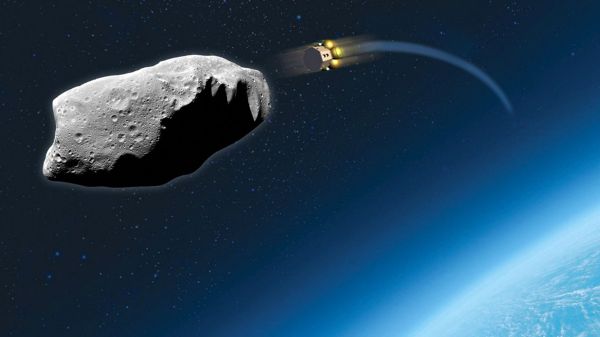Repurposed communications satellites could help save humanity from an asteroid impact
What do you do if you discover a big rock on a collision course with Earth and have very little time to take action?

Large satellites used for TV broadcasting could be quickly and easily repurposed as asteroid deflectors if a space rock were to threaten Earth, according to a study by the European aerospace company Airbus.
The study, part of a mission concept called Fast Kinetic Deflection (FastKD), was commissioned by the European Space Agency (ESA), as part of its effort to prepare for an apocalyptic scenario that will certainly happen one day (even though that day might be in a very distant future).
Telecommunication satellites that sit in the so-called geostationary orbit at the altitude of 22,000 miles (36,000 kilometers) circle Earth at a speed that matches the rotation of the planet, thus appearing permanently suspended above a certain region. These satellites are usually very large, like a small bus. They might weigh 4 to 6 tons, which would give them enough force to affect the trajectory of an approaching space rock.
Still, as Albert Falke, who led the FastKD study at Airbus, told Space.com, it would require maybe 10 such spacecraft hitting a 1,000-foot-wide (300 meters) asteroid within a short period of time to sufficiently change its trajectory to avoid the planet.
Related: Potentially dangerous asteroids (images)
Readily available
"These telecommunication platforms, in addition to being large and heavy, are also built with quite a high frequency," Falke said. "That means we can expect them to be available readily in the integration facilities [of satellite manufacturers]. That's something we can take for granted."
In 2019, for example, 15 geostationary satellites were ordered by commercial satellite operators worldwide, according to SpaceNews.
Sign up for the Live Science daily newsletter now
Get the world’s most fascinating discoveries delivered straight to your inbox.
In the scenario explored by Airbus, if astronomers detect an asteroid on a collision course with Earth, all satellite manufacturers around the world will have to start converting the telecoms satellites they are currently building into anti-asteroid weapons. All of these missions would have to launch within about one month to reach the asteroid at about the same time.
The combined effect of the satellites crashing into the Earthbound rock may change its trajectory by only an inch or two, but that would be enough to nudge it off course and prevent a disaster if done long enough before the expected impact.
"The bottleneck [for the success of such a mission] will be the rockets," Falke said. "We think we could expect about 10 to 15 launches available within one month around the entire globe."
Preparations needed
Airbus chose available technology instead of building a new spacecraft completely from scratch for one simple reason: Astronomers may only spot an asteroid on a collision course with Earth not that long in advance. The deflection mission might take anywhere between six to 18 months to reach its target, which might leave only about six months for the engineers to make the craft ready.
"The detection of asteroids has very much improved over the last decades," Falke said. "There are huge observation programs, mostly pushed by NASA. So all the big asteroids, 1 km (0.6 miles) in size and larger should be known. But of course, there are some which could not be observed in the past because their orbits are six to eight years, and their last close approach may have been before these telescopes were put in place," he added.
It is theoretically possible for a threatening asteroid to be spotted tomorrow, with only months left before a devastating encounter with Earth, Falke added. Some smaller bodies, such as the 2013 Chelyabinsk asteroid, which triggered a shockwave that injured about 1,200 people in Russia, may arrive completely unnoticed.
To be able to execute an Earth-saving mission in orbit, telecommunication satellites would have to be fitted with a special module that enables communication in deep space, as well as navigation and guidance required to approach the asteroid. These modules have yet to be developed. Ideally, they would be built and tested in advance and stand ready in case of an emergency.
"We do need to have concrete plans on how to make this deflection module and put it on the telecommunications platform," Falke said. "Then we need to perform very fast qualification and test activity before putting this deflection system on the launch pad."
Widespread destruction
Humankind, according to Falke, should want to be prepared. If a 1,000-foot-wide (300 m) asteroid, such as that envisioned in the Airbus study, hit somewhere in central Europe, it would cause widespread destruction across the whole continent.
"Such an impact would produce a shockwave and also firestorms and earthquakes," Falke said. "A lot of material would be thrown up into the atmosphere and then come down further away from the impact zone. I think the whole of Europe would have to be evacuated and all the flora and fauna would be destroyed in the months and years after such an impact."
Falke is cautious to say whether an asteroid larger than 1,000 feet (300 m) in diameter could still be deflected using this method. But that's an important question. The asteroid that led to the extinction of the dinosaurs some 60 million years ago is believed to have been at least 6 miles (9.6 km) in diameter.
"If the asteroid becomes larger [than 1,000 feet], it gets more difficult," Falke said. "But the good thing is that such big objects will be known a very long time in advance so we would have time to prepare."
Humankind seems to be in a better position than the dinosaurs. The world's first asteroid deflection experiment is set to take place next year when a NASA mission called DART is expected to ram into a small asteroid moon Dimorphos, which orbits a larger asteroid Didymos. The goal is to change the orbit of 520-foot-wide (160 m) Didymos with a 270-pound (600 kilograms) spacecraft.
The study results were presented at the Planetary Defence Conference 2021
Follow Tereza Pultarova on Twitter @TerezaPultarova. Follow us on Twitter @Spacedotcom and on Facebook.











